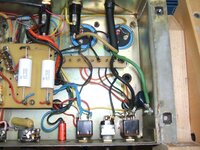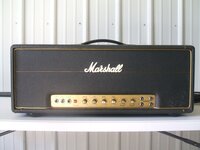H
harddriver
Well-known member
I've read some differing views on this and wanted to ask some questions, I have researched some post online about vintage Marshalls and the death cap and intalling ground plugs on them. I have already cut the old cord out and have a new 16/3 ready to go in. The amp did have a 3 prong grounded plug with the black(hot wire) feeding the input side of the bottom lug of the polarity switch and has a jumper wire over to the + side of the power switch, the white neutral wire feeds the mains fuse and the green is grounded to the chassis but the .047uf death cap is connected to the center lug of the polarity switch. The top lugs of the polarity switch has a light blue wire from the power transformer soldered across the lug to a yellow wire that connects to the output lug of the mains fuse.
Some say just clip the .047uf death cap out and you are good to go and leave the polarity switch as is wired. I will unsolder the death cap cleanly regardless but I may want to move my PPIMV into the old polarity switch hole so I can re-install the speaker jack I pulled out for the PPIMV years ago so I would need to unsolder the blue and yellow wires from the upper polarity lugs resolder them and apply some heat shrink tubing thus allowing removal of the polarity switch all together. But if I were to keep the polarity switch in for aesthetic reasons then the blue an yellow wire just remain soldered across those upper lugs.
We will leave the polarity switch in for the sake of this discussion. Unsoldering the .047uf death cap and leaving the blue and yellow wires soldered across the top lugs of the old polarity switch.
Here is where this other method I came across online differs from the first one and how the amp is wired right now. It states the the black(hot ) wire must be connected to the input lug of the mains fuse holder and the white neutral must be soldered to the power switch input lug and then of course green wire to the chassis ground lug as seen in the current pictures with the .047uf death cap removed of course.
Usually I would wire black(hot to input side of the power switch) and white(neutral) to the mains fuse as I have done on all my builds so far.
So which is the most correct method for the hot, neutral connection? Black(hot) to fuse/White(neutral) to power switch lug or Black(hot) to power switch lug/White(neutral) to fuse.
Of course green to chassis ground for both scenarios.
I have attached some pics as the amp was done by a tech before I got the amp and I just left things be. It was time for a new power cord and seen it still had the death cap in it so I figured it was high time to pull the death cap out.
Some say just clip the .047uf death cap out and you are good to go and leave the polarity switch as is wired. I will unsolder the death cap cleanly regardless but I may want to move my PPIMV into the old polarity switch hole so I can re-install the speaker jack I pulled out for the PPIMV years ago so I would need to unsolder the blue and yellow wires from the upper polarity lugs resolder them and apply some heat shrink tubing thus allowing removal of the polarity switch all together. But if I were to keep the polarity switch in for aesthetic reasons then the blue an yellow wire just remain soldered across those upper lugs.
We will leave the polarity switch in for the sake of this discussion. Unsoldering the .047uf death cap and leaving the blue and yellow wires soldered across the top lugs of the old polarity switch.
Here is where this other method I came across online differs from the first one and how the amp is wired right now. It states the the black(hot ) wire must be connected to the input lug of the mains fuse holder and the white neutral must be soldered to the power switch input lug and then of course green wire to the chassis ground lug as seen in the current pictures with the .047uf death cap removed of course.
Usually I would wire black(hot to input side of the power switch) and white(neutral) to the mains fuse as I have done on all my builds so far.
So which is the most correct method for the hot, neutral connection? Black(hot) to fuse/White(neutral) to power switch lug or Black(hot) to power switch lug/White(neutral) to fuse.
Of course green to chassis ground for both scenarios.
I have attached some pics as the amp was done by a tech before I got the amp and I just left things be. It was time for a new power cord and seen it still had the death cap in it so I figured it was high time to pull the death cap out.




